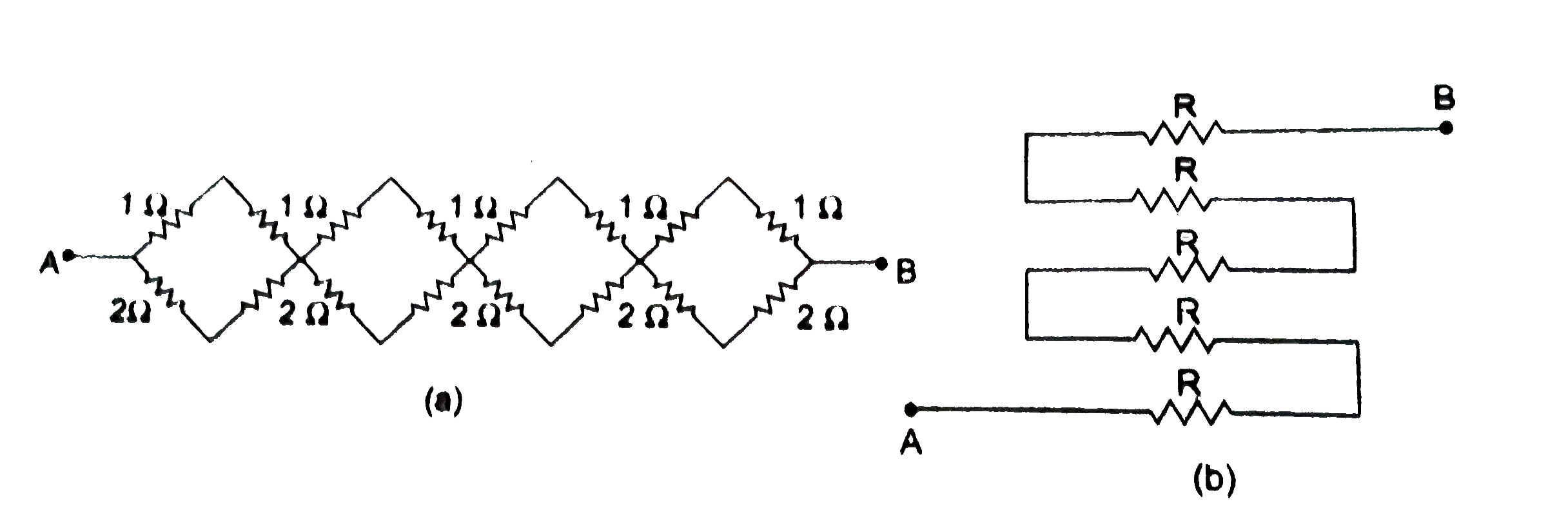Given the resistances of 1Ω,2Ω,3Ω how will be combine them to get an equivalent resistance of (i) (11/3) Ω (ii) (11/5) Ω (iii) 6Ω (iv) (6//11) ΩSolution in Telugu
It is to be noted that (a) the effective resistance of parallel combination of resistors is less than the individual resistance and (b) the effective resistance of series combination of resistors is more than individual resistance.
Case (i) Parallel combination of 1Ω and 2Ω is connected is series with 3Ω
Effective resistance of 1Ω and 2Ω in parallel will be given by
RP=1×21+2=23Ω
∴ Equivalent resistance of 23Ω and 3Ω in series
=23+3=113Ω ,
Case (ii) : Parallel combination of 2Ω and 3Ω is connected in series with 1Ω Equivalent resistance of 2Ω and 3Ω in parallel
=2×32+3=65Ω
Equivalent resistance of 65Ω and 1Ω in series =65+1=115Ω
Case (iii) : All the resistance are to be connected in series show
∴ Equivalent resistance =1+2+3=6Ω
(Case (iv) : All the resistance are to be connected in parallel
∴ Equivalent resistance (R ) is given by
1R=11+12+13
=6+3+26=116 or r=611Ω
Topper's Solved these Questions
- CURRENT ELECTRICITY Book:VIKRAM PUBLICATION ( ANDHRA PUBLICATION)Chapter:CURRENT ELECTRICITY Exercise:TEXTUAL EXERCISES
Explore 34 Videos
- COMMUNICATION SYSTEMBook:VIKRAM PUBLICATION ( ANDHRA PUBLICATION)Chapter:COMMUNICATION SYSTEMExercise:TEXTUAL EXERCISES
Explore 8 Videos
- DUAL NATURE OF RADIATION AND MATTERBook:VIKRAM PUBLICATION ( ANDHRA PUBLICATION)Chapter:DUAL NATURE OF RADIATION AND MATTERExercise:DAM SURE (VSAQ)
Explore 2 Videos
Similar Questions
The storage battery of a car has an emf of 12 V. If the internal resistance of the battery is 0.4Ω, what is the maximum current that can be drawn from the battery?
View SolutionWhich of the following frequencies will be suitable for beyond the horizon communication using sky waves ?
View SolutionThe wavelength of electromagnetic radiation is doubled. What will happen to the energy of the photons of the new radiation ?
View Solution(a) Given n resistors each of resistance R . How will you combine them to get the (i) maximum (ii) minimum effective resistance ? What is the ratio of the maximum to minimum resistance ? (b) Given the resistances of 1 Omega, 2 Omega, 3 Omega , how will you combine them to get an equivalent resistance of (i) (11//3)Omega (ii) (11//5)Omega (iii) 6 Omega (iv) (6//11) Omega ? (c) Determine the equivalent resistance of networks shown in Figure.
View SolutionGiven the resistance of 1Ω,2Ω,3Ω, how will you combine them to get an e3quivalent resistance of :
113Ω (ii)115Ω (iii)6Ω 611Ω ?
View Solution(a) आपको R प्रतिरोध वाले n प्रतिरोधक दिए गए है । (i) अधिकतम (ii) न्यूनतम प्रभावी प्रतिरोध प्राप्त करने के लिए आप इन्हें किस प्रकार संयोजित करेंगे ? अधिकतम और न्यूनतम प्रतिरोधों का अनुपात क्या होगा ?
(b) यदि 1Ω,2Ω,3Ω के तीन प्रतिरोध दिए गए हों तो उनको आप किस प्रकार संयोजित करेंगे कि प्राप्त तुल्य प्रतिरोध हों : (i)(11/3)Ω,(ii)(11/5)Ω,(iii)6Ω,(iv)(6/11)Ω?
(c) चित्र 3.31 में दिखाए गए नेटवर्कों का तुल्य प्रतिरोध प्राप्त कीजिए ।

View Solutionयदि 1Ω,2Ω,3Ω के तीन प्रतिरोध दिए गए हो, तो उनको आप किस प्रकार संयोजित करेंगे की प्राप्त तुल्य प्रतिरोध हो - (i) (11/3)Ω (ii) (11/5)Ω (iii) 6Ω (iv) (6/11)Ω ?
View Solution(a) R प्रतिरोधवाले n प्रतिरोधकों को लेकर आप उन्हें किस प्रकार जोड़ेंगे ताकि तुल्य प्रतिरोध (i) महत्तम तथा (ii) न्यूनतम हो ? महत्तम तथा न्यूनतम प्रतिरोधों का अनुपात क्या होगा ?
(b) यदि 1Ω,2Ω,3Ω के तीन प्रतिरोधक दिए गए हो, तो उन्हें आप किस प्रकार संयोजित करेंगे की तुल्य प्रतिरोध के मान (i) 113Ω,(ii)115Ω,(iii)6Ω.(iv)611Ω हो ?
(c) चित्र 2.1−7 (a) और (b) में प्रदर्शित प्रतिरोधकों के संयोजक के लिए A एवं B के बीच तुल्य प्रतिरोध ज्ञात करे।

View Solution(a) Given n resistores each of resistance R. how will you combine them to get the (i) maximum (ii) minimum effective resistance? (b) Given the resistances of 1 Omega, 2 Omega, 3 Omega. how will be combine them to get an equivalent resistance of (i) (11//3) Omega (ii) (11//5) Omega, (iii) 6 Omega, (iv) (6//11) Omega ? (c ) Determine the equivalent resistance of networks shown in
View SolutionGiven the resistances of 1Ω,2Ω,3Ω how will we combine them to get an equivalent resistance of (i) (113)Ω,(ii)(115)Ω,(iii)6Ω,(iv)(611)Ω ?
View SolutionGiven the resistances of 1Ω,2Ωand3Ω. How will you combine them to get an equivalent resistance of
(i) 113Ω ?
(ii) 115Ω ?
View SolutionGiven three resistors of resistances 1 Omega, 2Omega and 3Omega . How will you combine them to get an equivalent resistance of (11)/(5) Omega ?
View Solution(a) Given n resistores each of resistance R. how will you combine them to get the (i) maximum (ii) minimum effective resistance? (b) Given the resistances of 1 Omega, 2 Omega, 3 Omega. how will be combine them to get an equivalent resistance of (i) (11//3) Omega (ii) (11//5) Omega, (iii) 6 Omega, (iv) (6//11) Omega ? (c ) Determine the equivalent resistance of networks shown in
View Solution(a) Given n resistors each of resistance R . How will you combine them to get the (i) maximum (ii) minimum effective resistance ? What is the ratio of the maximum to minimum resistance ? (b) Given the resistances of 1 Omega, 2 Omega, 3 Omega , how will you combine them to get an equivalent resistance of (i) (11//3)Omega (ii) (11//5)Omega (iii) 6 Omega (iv) (6//11) Omega ? (c) Determine the equivalent resistance of networks shown in Figure.
View Solution(a) Given n resistores each of resistance R. how will you combine them to get the (i) maximum (ii) minimum effective resistance?
(b) Given the resistances of 1Ω,2Ω,3Ω. how will be combine them to get an equivalent resistance of (i)(11/3)Ω(ii)(11/5)Ω,(iii)6Ω,(iv)(6/11)Ω ?
(c ) Determine the equivalent resistance of networks shown in

View Solution

